If Big Tobacco had a promised land, it would be China.
Home to over 300 million smokers – almost the entire population of the US – the country literally feeds off cigarette sales, generating more in tobacco tax revenue every year than it spends annually on the military.
Cigarettes in China aren’t merely the sign of a bad habit – they’ve become part of the culture. Looking to show your bao’an some gratitude? Hand him a smoke. Attending a Chinese wedding reception? Expect banquet tables stocked with packs of Double Happiness.
Domestic demand alone pushes the state-owned China National Tobacco Corporation to manufacture roughly 40 percent of the world’s cigarettes every year. That makes China the greatest producer – and as the WHO points out, consumer – of tobacco in the world.
“Thinking about Chinese smoking statistics is like trying to think about the limits of space.”
– Robert Fletcher, Rothmans’ former regional public affairs manager, 1992
But this is hardly a success story. The tobacco epidemic is one of the biggest public health threats facing China this century. More than one million mainland smokers die prematurely from tobacco-related disease every year, and if current trends continue, that number will rise to two million by 2030, according to a joint study by researchers at Oxford University, the Chinese Academy of Medical Sciences and the Chinese Center for Disease Control.
READ MORE: Cancer Claimed 2.8 Million Deaths in China in 2015
“The worst of the epidemic isn’t here yet. It’s yet to come,” says Dr. Homer Tso, head of the tobacco control board at the University of Hong Kong-Shenzhen Hospital and former chairman of the Hong Kong Council on Smoking and Health.
When we meet Tso in Shenzhen, he wears a red bowtie and carries three business cards. Speaking with a slow confidence and occasionally diverging into medical terms (“Morbidity is the issue,” he says at one point), Tso explains that the real drain and risk to Chinese society is not death from tobacco, but mounting medical costs used to treat patients with cancer, stroke and heart disease – all ailments directly related to smoking.
China has pledged to curb tobacco consumption on a number of occasions. In 2003, it signed the WHO Framework Convention on Tobacco Control, which called for a ban on tobacco advertising, major tax hike and improved cessation assistance – “time proven measures in tobacco control,” according to Tso.
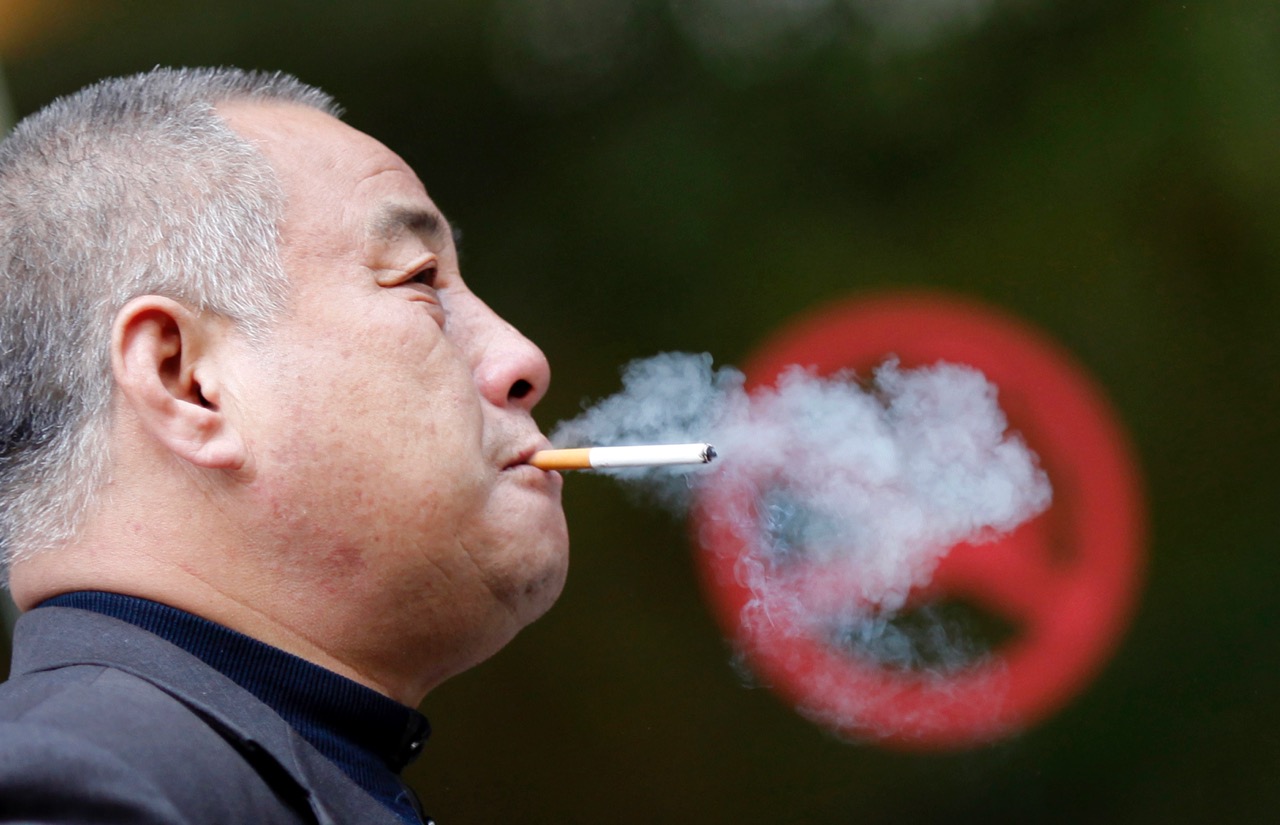
China announced it would issue a nationwide ban on smoking in public by the end of 2017
To China’s credit, some of that has happened. The government raised the tax on wholesale cigarettes from 5 to 11 percent in 2015 – the same year Beijing banned smoking in indoor public places. (A nationwide ban is set to take place by the end of this year). Perhaps in part due to First Lady Peng Liyuan’s hard stance towards tobacco, President Xi Jinping also now requires high-level cadres to refrain from smoking in public and during conferences.
READ MORE: China to Issue Nationwide Public Smoking Ban
“These are steps,” Tso tells us. “It’s a big country. It takes time. But it is happening.”
In 2016, China finally saw what it claimed was the impact of its new legislation: tobacco consumption was reported to have dropped for the first time in 20 years. Not by much – about 2.4 percent according to Euromonitor – but enough to bring China Tobacco to declare, for the first time ever, that the volume of the world’s largest tobacco market had gone into a downward spiral.
But this isn't just because of new policies. The past two years have also seen the rise of a new tribe of Chinese street-style-loving millennials.
Welcome to the world of vaping.
* * *
Fei Xiang doesn’t remember hearing about China Tobacco’s first fall – he was too busy drafting a letter of resignation.
It was October 2016, and the 27-year-old had resolved to quit his desk job and open a vape shop in Guangzhou with a friend. They figured vaping might catch on one day.
“We saw there was potential for this market. It was new, after all, and there could be opportunities.”
Now in what Fei calls a “period of rapid development,” China’s vaping industry is expanding too fast not to notice. Whereas just two years ago, it would have been hard to spot a vape shop in first-tier cities like Shanghai, Beijing or Guangzhou, today, there are close to a hundred in each, all selling a wide range of vaporizers and e-liquids.
Walk around Beijing's Gulou area, for example, and you will see shops with goofy names like 'Vape Professor' or 'Vape Saint' alongside more traditional ones selling tobacco cigarettes.
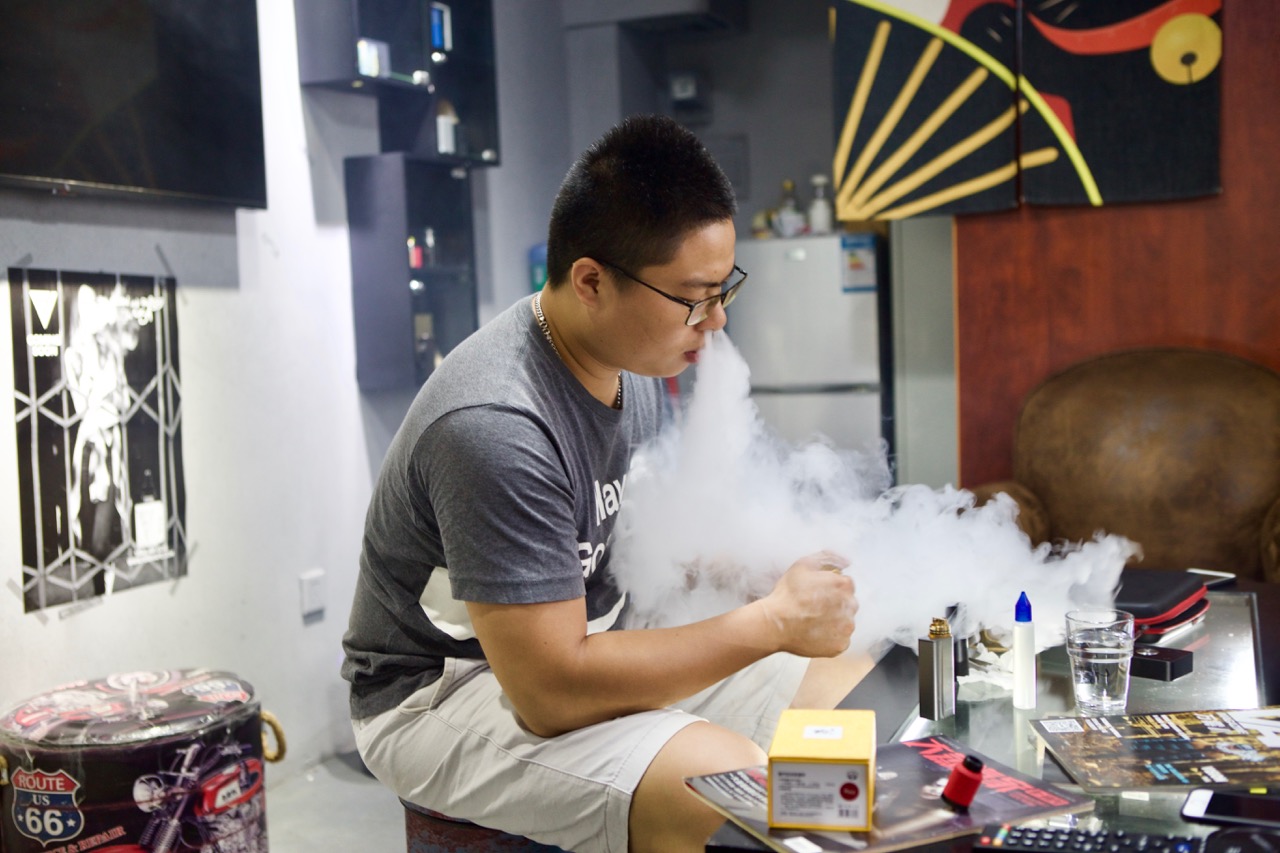
Fei Xiang tests a new mod in his Guangzhou shop Vape Club (photo by Jocelyn Richards)
As China moves to lower tobacco use, vaping looks poised to play a pivotal role, offering smokers an increasingly convenient – and potentially healthier – alternative to cigarettes.
“The culture is developing quite quickly, since people are raising their standards for health,” suggests Brian Bai, the founder of Tianjin’s first vape lounge, which opened last December. “Vaping is no doubt seeing an upwards trend, and cigarettes will slowly get replaced by vape.”
Vape store owners across the country agree that the industry’s ‘big boom’ started in late 2016 — the same year studies announced the first drop in China's tobacco sales — though distributors in northern China were developing the market as early as 2013.
Compared to the West, where vaping gained traction a decade ago, China might look late to the game. But China's love affair with smokeable vapor began long before that. It was Chinese pharmacist Hon Lik who invented the first e-cigarette back in 2003 – a device he hoped would help him quit smoking after the same habit killed his father.
“The culture is developing quickly.”
In the years following his invention, a production hub was established in southern China, exporting hardware to countries all over the globe. Today, roughly 90 percent of the world’s e-cigarettes and vaporizers still come from Shenzhen. Like iPhones, brand-name vapes are manufactured in China and exported abroad before returning to the mainland again as ‘imports’ and taxed accordingly.
Until recently, the Chinese government had little reason to regulate the industry. Vaping devices were primarily created for overseas consumers, after all, not Chinese.
But as a growing number of mainlanders adopt the hobby and open vape shops of their own, the dearth of regulatory framework is turning out to be a big problem.

Chinese youth try vaping at the IECIE Vape Shenzhen eCig Expo 2017 (photo via Aspire)
When applying for a business license for his shop, Vape Club, last fall, Fei says he could choose from any number of classifications: electronics, wholesale trade, tech, bio-tech and even ‘cultural development’ company – all of which have been used to register vape retailers in the past.
“The licensing official looked at me and asked, ‘so what are you actually selling, tobacco products or electronics?’ and I just said, ‘well, there is still no law to define this thing, but our products are probably closest to electronics – there is no tobacco involved – so we’ll just define our shop as an electronics store.’”
Confusion over what exactly constitutes an e-cigarette isn’t unique to China – a Google search rounds up plenty of literature on the subject.
While the media often refers to all vaping devices as ‘e-cigarettes,’ the term is typically reserved for those that look and feel like traditional cigarettes. E-cigs sold in convenience stores come with prefilled cartridges of e-liquid, have limited flavor options and are disposable.
Then there are ‘vaporizers,’ the devices you’ll find in an actual vape shop that span from ‘advanced personal vaporizers’ (APVs) or ‘vape pens’ to walkie-talkie-size ‘mods,’ which are more customizable and more expensive. Instead of replacing cartridges, users pour fresh e-liquid (a substance sometimes known as 'vape juice') into the device. Vaporizers, not e-cigarettes, are what make the subculture.
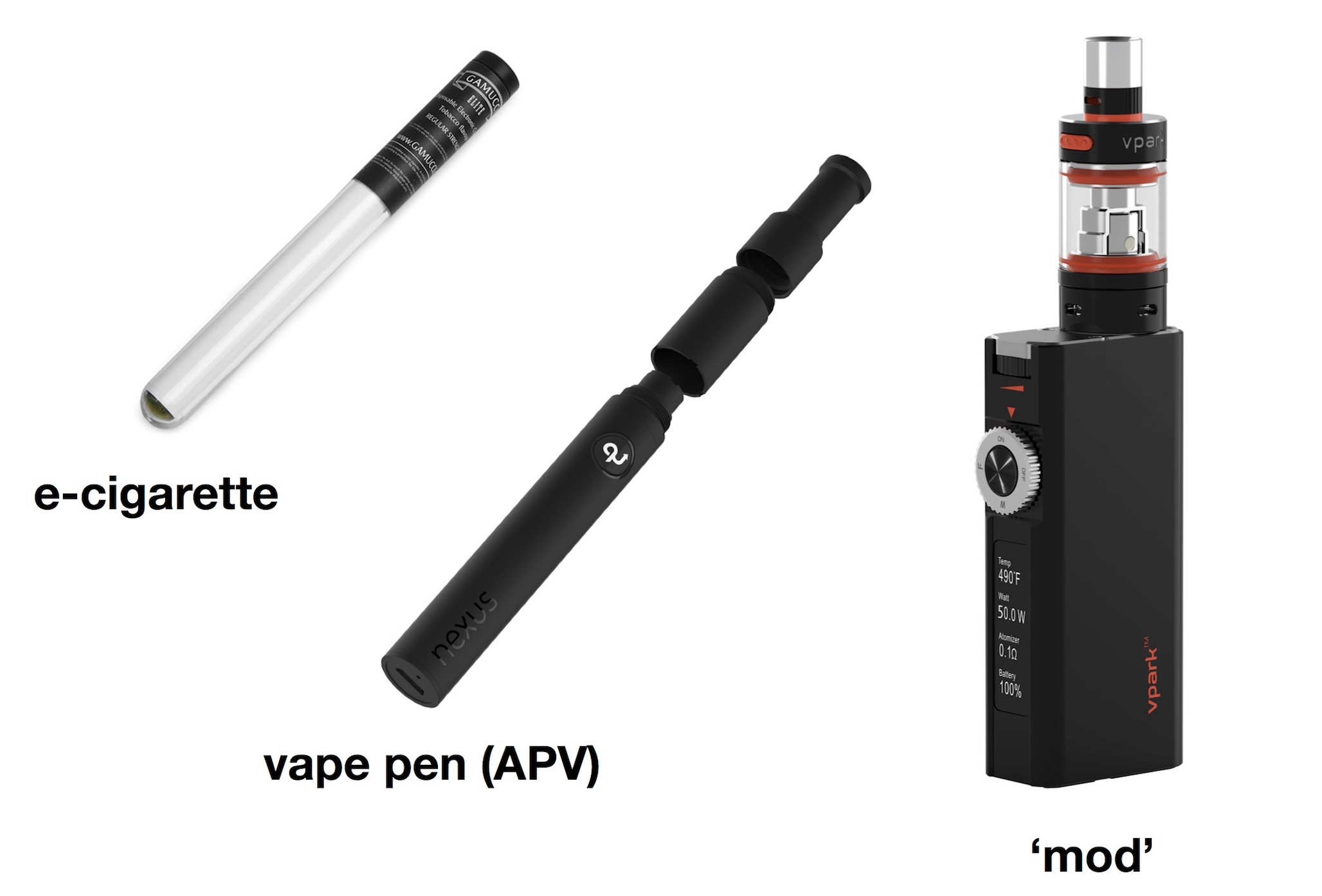
Products are colorful and come in different materials, shapes and flavors. E-liquids have names like ‘Mr Who’ and ‘Passion Dude.’ Vape stores across Beijing all seem to play the same video on loop, in which trendy-looking young people in nightclubs blow funnels of smoke into the air to a hip-hop soundtrack.
Just as traditional smoking has a long history of being marketed as rebellious and cool, the same tactics are being used by the vaping industry. At Cyovape, a chain of vape stores in Beijing, a TV plays a video of vaping young people as a shop assistant blows smoke ring after smoke ring. (It looks pretty cool, we admit.)
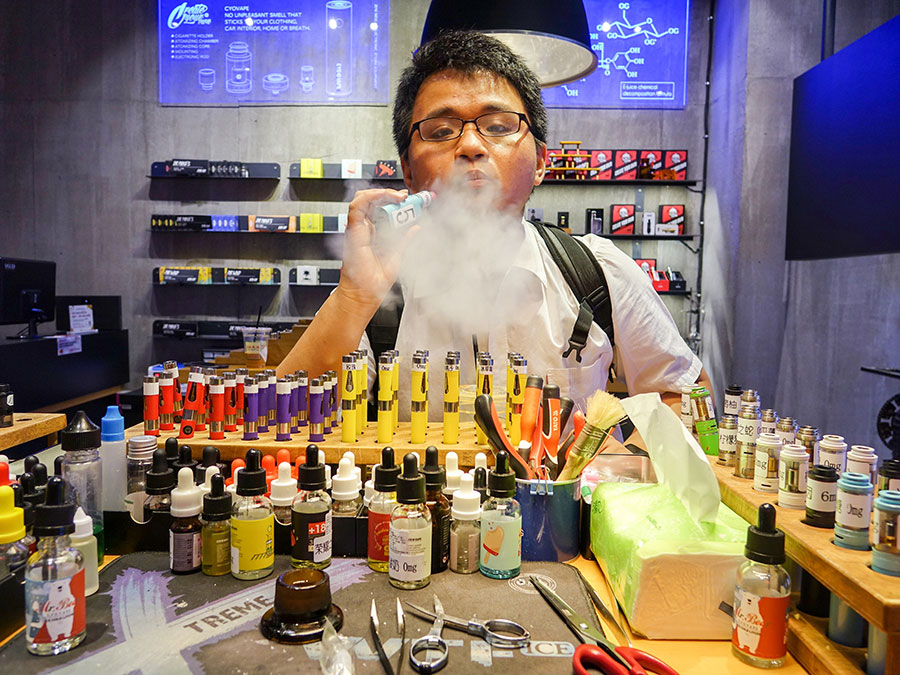
A customer surnamed Liu samples e-liquid flavors at Beijing vape shop Cyovape (photo by Dominique Wong)
And yet, Cyovape’s customers range from students and young professionals to 60-year-olds, the shop assistant tells us. Products sell for as low as RMB60 to as high as RMB3,000.
“I don’t smoke,” says the assistant. “But I took up vaping after I started working here. Before, I didn’t even know what vaping was. I think it’s really fun.”
A customer surnamed Liu samples a few e-liquids. The Beijing local says he only vapes occasionally. “I’m just curious. I like to try the different flavors. It’s safer than normal cigarette smoking.”

Vaping is almost certainly less harmful than traditional cigarette smoking — and a strong scientific consensus now suggests it is — but information about its long-term effects is still murky. In study released by Public Health England in 2015, vaping was found to be 95 percent less harmful than smoking tobacco. This past February, new research carried by the Annals of Internal Medicine suggested e-cigarettes are “far safer” than smoking and have low risks associated with long-term use.
In China, though, where awareness of tobacco’s health effects is still limited, knowledge of vaping’s impact on the body is rudimentary at best.
Fei says his favorite reactions come from elderly people who spot him vaping on the street.
“They’ll say to me, ‘Why is the smoke so big? It's like a chimney!’ Or, ‘There must be chemicals in that. You should stick with classic cigarettes, young man.’”
What most people don’t realize, he says, is that the chemicals found in e-liquids (such as propylene glycol) are used in many processed foods too. “We consume this stuff every day in China, they just don’t know it.”
WATCH: We Asked Chinese Smokers What They Think of Vaping
Still, hesitancy towards vaping remains, and not only among Chinese laobaixing. Last November, the WHO warned all 180 signatories of the Framework Convention on Tobacco Control that electronic smoking devices are “unlikely to be harmless,” and long-term use is expected to increase the risk of various diseases associated with smoking.
For many Chinese, vaping is a great way to wean off Double Happiness. But others warn that vaping, with its bright apparatuses and candy-flavored e-juices, tends to attract youth, and could be a gateway into smoking.
The Hong Kong government is among those to cite the ‘gateway’ argument, one of the reasons it plans to outlaw all e-cigarettes by next year. Already, possessing or selling an e-cigarette liquid containing nicotine in Hong Kong carries a potential penalty of up to two years in prison and a HKD100,000 fine.
The teenagers we meet in China’s vape stores, however, all say they were smokers long before they tried vaping, and their claim isn’t surprising. About two-thirds of young men in China smoke, and most start before the age of 20, according to research published in The Lancet from two large, nationally representative studies conducted 15 years apart.
Smoking – at least in China – is more likely a gateway to vaping, and not the other way around.
* * *
“Every smoker is a potential vaper,” says Sean Dickinson, cofounder of Shanghai Vape, one of just three vape stores in the city when it opened in 2015 in Jing'an district. Though most of his customers are young, tattooed males between the ages of 20 and 35 (“your typical early adopters in China”), Dickinson says the smoking crowd promises plenty of diversity.
READ MORE: Shanghai Gets its First Shop Dedicated to Vaping
“There’s a huge mix of vapers, just like how smokers span all sorts of demographic groups,” he explains, adding that it’s important to differentiate between people who are trying to quit smoking and those who consider vaping a hobby.
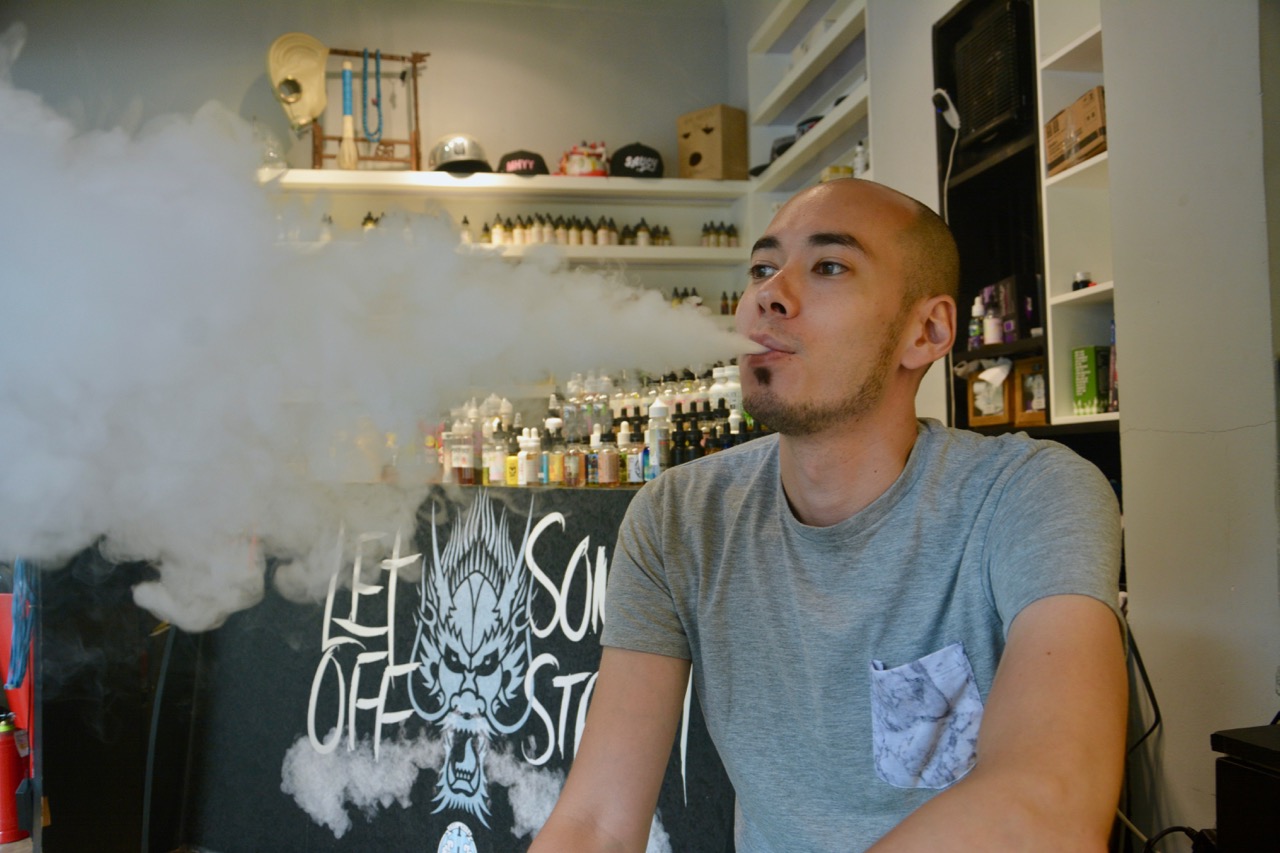
Sean Dickinson in Shanghai Vape (photo by Dominic Ngai)
At this time, two uniformed officers with the words ‘Te Qin 特勤’ written across their backs came into the shop. What we initially thought was some sort of police inspection, turned out to be a shopping experience of two curious first-time vapers.
The two men – one in his 30s, another in his 50s – belong to a SWAT team stationed in the neighborhood. After about 15 minutes of browsing, tasting and inquiring about different vaporizers and e-liquids with Dickinson’s help, the younger officer made his purchase – the newest member of China’s growing vaping community was born.
“People who are trying to give up smoking could be anyone – 68-year-old retired Shanghainese men to college students,” Dickinson continues. “Then, there are the hobbyists, and many people vape as a hobby in Shanghai,” he says, referencing the police officer, who clearly stated he had no intention of quitting smoking, but wanted to take up vaping because it looks “fun.”
“Every smoker is a potential vaper."
“I think he actually has the desire to quit, but is afraid to admit it in front of his colleague. In China, it’s manly to smoke, but it’s not manly to use e-cigarettes,” he says.
Like most subcultures in China, Dickinson says vaping is bred and kept alive online. Every vape shop has its own WeChat group, and vapers are constantly posting about the latest gadgets.
But even with its growing online community, Dickinson claims vaping is still in the early adopter phase in China. “It takes time to change, same as in the West…” he explains. “You need a certain number of people to get to a tipping point for vaping to become mainstream and culturally acceptable.” He estimates it will take China “maybe another year” to get to that tipping point.
* * *
Acquiring mainstream acceptance might only be half the battle. China’s vaping market is still new and largely unregulated, and numerous challenges persist. Fake products, fickle suppliers and ‘lowballers’ are just a small sample of the problems facing vape retailers today.
Kiki Cheung, marketing manager for Shenzhen-based e-liquid line Aspire, says questions over fake e-juices abound. It’s often unclear what raw materials are used in their manufacture, she says, and factory conditions remain a mystery. “[Fake e-liquids] are a serious problem. For consumers, using fake vape juices affects not only the vaping experience but also their health.”
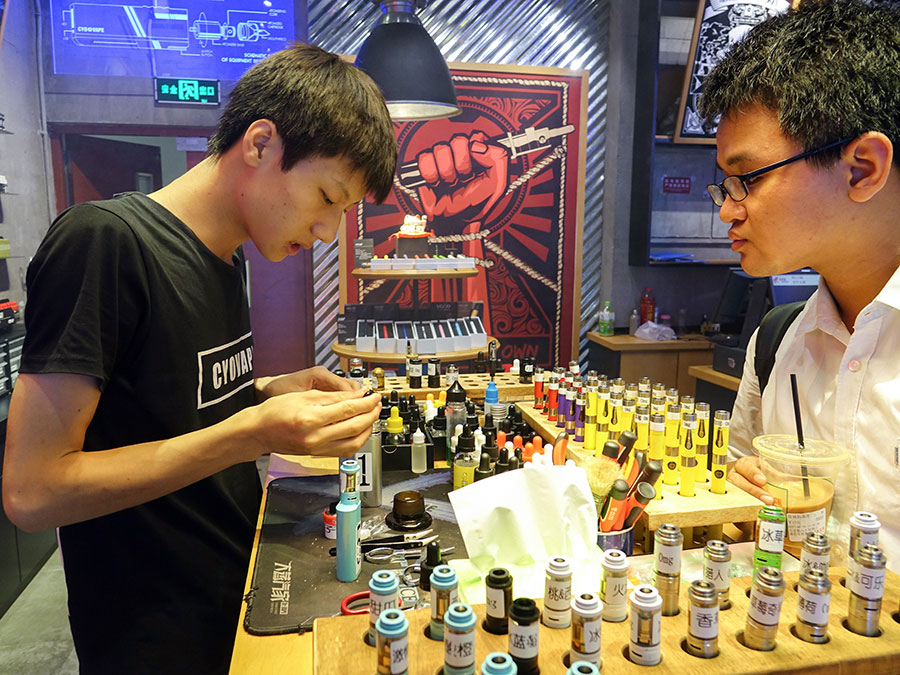
A Cycovape store assistant explains some of the shop's vape products to Liu (photo by Dominique Wong)
And then there’s the issue of lowballing, where reputable e-liquids are sold well below their listing price, jeopardizing brands – and the stability of the entire industry – in the process.
Such has been the experience of Tommy Lin, a former PGA pro golfer who, at the request of a distant relative, invested in a Shenzhen vape factory in 2007. He later moved into the e-juice business through Organic Labs – a Las Vegas-based company that manufactures high-grade e-liquids designed by a master mixologist and culinarian. Their biggest customer? China, of course.
It wasn't until Lin visited a vape show in Shenzhen in 2015, however, that he saw the Chinese demand for e-liquid first-hand.
The market, he says, is unlike the usual mix of manufacturers, wholesalers and consumer retail shops that exist in the US. “In China, it’s almost like a multi-level marketing scheme, [e-liquids] probably go through six or seven hands before reaching the final buy.”
“This industry is too chaotic.”
Lin entered the Chinese market with 10 e-liquids in 2015. Now, only three are still selling. “Two or three lines, I had to learn a lesson – I gave it to the wrong guy and got burned.”
He says his company often has to go on Taobao to get rid of counterfeits and underpriced e-juices. “If the fifth guy on the chain is lowballing and dumping stuff on Taobao, then the third and second guy are not going to buy,” he explains.
The inconsistency of prices is a complaint shared by many vape stores owners we talk to, including Fei in Guangzhou.
“This industry is too chaotic. You might buy five bottles of the same exact e-liquid and pay a completely different price for each of them. One of them might turn out to be fake. Or it’s real but you paid too much for it.”

Vape juices labeled in Chinese at a shop in Guangzhou (photo by Jocelyn Richards)
No source is 100 percent reliable, according to Fei. Even suppliers he knows personally have sent him fakes by accident, claiming they couldn’t visibly tell the difference.
“I just hope the country will introduce laws to supervise this,” he says, taking a long hit on a new China-designed mod by Vape Kungfu. “So that this industry can develop healthily, unlike now, where there is no order and it’s all up to the individual.”
In 2015, the National Health and Family Planning Commission stated its intent to regulate the production, sale and use of e-cigarettes on the mainland. But so far, no restrictions have been enforced.
China is one of the few countries in Asia (along with South Korea, the Philippines and part of Malaysia) that still allows vaping. Brunei, Cambodia, Indonesia, Singapore, Thailand and Vietnam have all banned e-cigarettes, while Japan restricts any device that contains or dispenses nicotine. In Taiwan, all e-cigarette related products require a license to use, though, oddly, no licenses have ever been issued.
Fei predicts it might not be e-cigarettes that eventually push Chinese lawmakers to regulate the vaping industry, but tobacco.
A relatively new (and still untaxed) technology known as ‘heat-not-burn’ cigarettes, he says, has recently entered China and is already taking Japan and South Korea by storm. Designed to heat tobacco sticks just enough to release a flavorful nicotine-containing vapor – but no smoke – heat-not-burn devices supposedly emit fewer harmful chemicals than cigarettes, while still offering the same feel.

The iQos heat-not-burn device (photo via PMI)
Online ads for popular brand iQos have perked Chinese netizens’ interest, with some commenting they’ll try any alternative that offers a realistic smoking experience – even if it is outrageously expensive.
iQos is the latest product from tobacco giant Philip Morris International, and an attempt to cash in on an industry that’s increasingly ‘electrifying,’ as Alex Frew McMillan, a Hong Kong-based freelance reporter at Dragonfly Media, puts it.
An avid vaper himself, McMillan says the success of iQos in Japan is likely due to lobbying by cigarette companies. Otherwise, he asks, why would the country outlaw devices that “essentially turn gelatin-based liquid into steam” and legalize something that heats real tobacco?
“Big tobacco companies are looking to get in on the [e-smoking] market… They’re also pushing for higher taxes or equal taxes on e-cigarettes.” But if vaping devices truly are safer than newfangled ‘heat-not-burn’ cigarettes, he believes issuing a lower tax on them is in the best interest of countries in the long term.
“Smoking rates are trending in the wrong direction... I just hope they will choose to take it seriously."
“These are debates that governments really haven’t had,” says McMillan. “If [vapes] are healthier, it places less strain on the public health system down the line – fewer people with lung cancer and fewer people missing work.”
And that, ultimately, is a choice China has to make. Will the country rely on smoking cessation alone to avert the human and economic consequences of a tobacco epidemic? Or, will it choose to support an alternative that, while not flawless, has been shown to be significantly safer than conventional cigarettes?
Regardless, the future of vaping, it seems, still largely hinges on the future of tobacco.
“I think that the present government hasn’t really decided how seriously to take smoking,” Sir Richard Peto, an epidemiologist who has studied smoking rates in China since the 80s, tells us from his office in England. “There’s been a lot done for health in China over the last 10-15 years. Death rates are going down. Smoking is one of the few things that is trending in the opposite direction... and I just hope they will choose to take it seriously."
Additional reporting by Sky Thomas Gidge, Dominic Ngai, Dominique Wong and Tristin Zhang
[Cover image purchased for media use via hellorf.com]
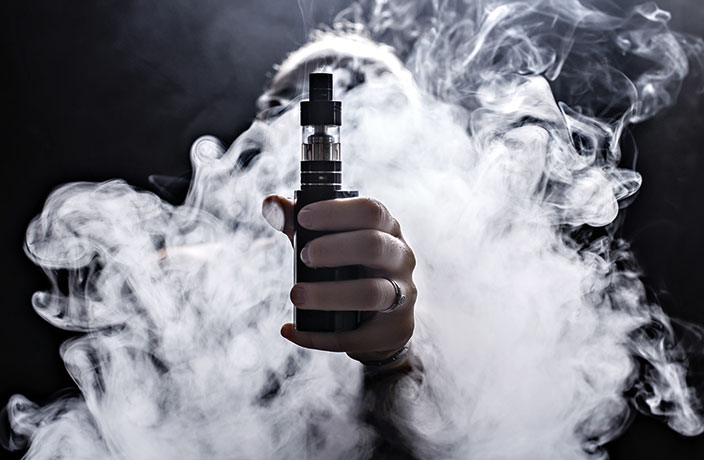




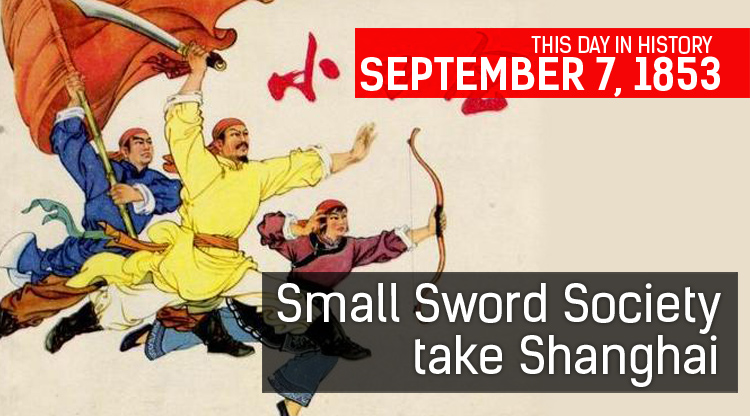
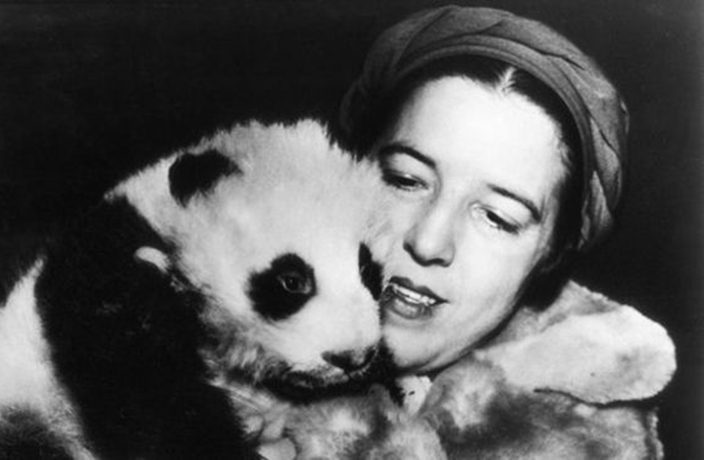














1 User Comments